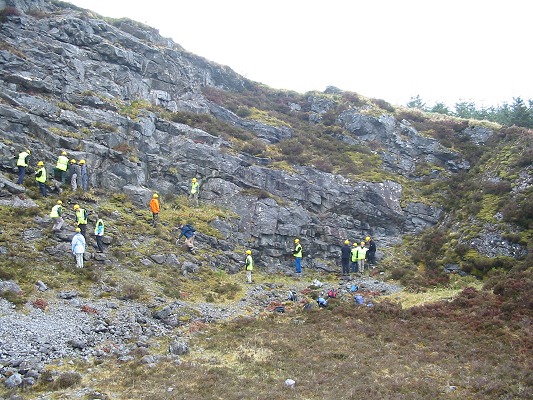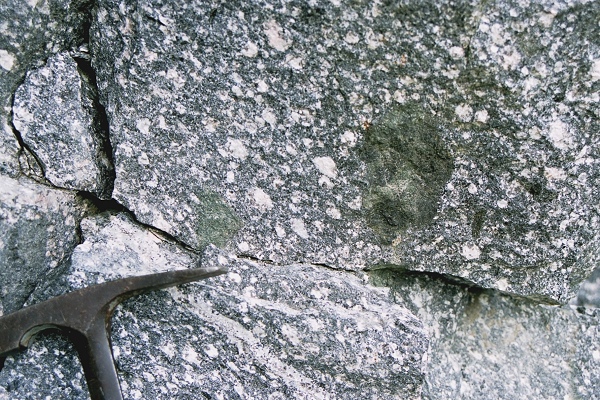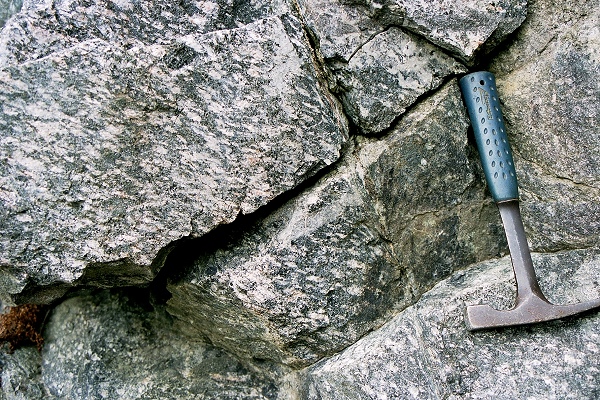
| Home | Geological History | Stratigraphy | Area map | Rock Index | About |
| Scourie | Achmelvich | Laxford | Clachtoll | Stoer | Assynt | Skiag Bridge | Glencoul | Knockan | Borralan | Ledmore |
The largest body of igneous rock in this area is found around Loch Borralan, and it has been named the Loch Borralan Complex. It is an intrusion composed of a variety of coarse-grained alkaline rock types, from dark to light in colour. The most abundant light-coloured rocks are not granites but syenites, made up mostly of potassium feldspar. Dark varieties are rich in mafic minerals such as pyroxene and garnet. One intermediate variety is so distinctive that it has been given its own name, borolanite (from an old spelling of the name of the loch).

![]() The borolanite can be studied in the small disused quarry
at Aultivullin.
The borolanite can be studied in the small disused quarry
at Aultivullin.
The importance of the Loch Borralan igneous rocks for the history of the area is that some of the varieties were intruded before the movements on the Moine Thrust zone, and so are deformed, whereas others were intruded after them, and so cut across the thrusts. Radiometric dating of minerals in the igneous rocks tells us their time of intrusion (about 430 million years) so we can also deduce the age of the thrust movements.

![]() This is the typical white-spotted nepheline syenite,
borolanite. However, it also contains a dark green fragment
about 10 cm across of a pyroxene-rich mafic rock. Such
rocks occur elsewhere in the Complex, and were intruded at
an earlier stage in its development. This piece was
probably broken off and carried in with the nepheline
syenite magma as a xenolith (literally, a foreign
rock). Xenoliths are common in many igneous rocks.
This is the typical white-spotted nepheline syenite,
borolanite. However, it also contains a dark green fragment
about 10 cm across of a pyroxene-rich mafic rock. Such
rocks occur elsewhere in the Complex, and were intruded at
an earlier stage in its development. This piece was
probably broken off and carried in with the nepheline
syenite magma as a xenolith (literally, a foreign
rock). Xenoliths are common in many igneous rocks.

![]() Crucial relationships between crystallisation of the 430
million year old igneous rocks and movements in the Moine
thrust zone are shown by the syenites in Alltivullin
quarry. In this view, the white spots in the borolanite
have been flattened (since they are solid crystals, this
would only be possible at high temperature, before the rock
had fully cooled). Also, just to the left of the hammer, a
small, later zone of sheared rock cuts the borolanite.
Crucial relationships between crystallisation of the 430
million year old igneous rocks and movements in the Moine
thrust zone are shown by the syenites in Alltivullin
quarry. In this view, the white spots in the borolanite
have been flattened (since they are solid crystals, this
would only be possible at high temperature, before the rock
had fully cooled). Also, just to the left of the hammer, a
small, later zone of sheared rock cuts the borolanite.
Other small intrusions in neighbouring areas include sills and dykes, commonly emplaced into the Cambrian sediments. Sills are sheets of igneous rock intruded parallel to the bedding of the enclosing sediments, and dykes are steep, cross-cutting sheets. A sill would normally be connected somewhere to a dyke that acted as its feeder, bringing magma up from depth. Dykes and sills, being relatively thin, crystallize more rapidly that larger intrusive bodies, but more slowly than lavas. As a result they tend to have an intermediate grain size.
|
|
|
|
Quartz syenite, Loch Borralan Igneous Complex Loch Borralan |
|
|
Nepheline syenite (borolanite), Loch Borralan Igneous Complex Aultivullin, near Loch Borralan |
|
Hornblende syenite from intrusive sill Inchnadamph, near Loch Assynt |
| Scourie | Achmelvich | Laxford | Clachtoll | Stoer | Assynt | Skiag Bridge | Glencoul | Knockan | Borralan | Ledmore |
| Home | Geological History | Stratigraphy | Area map | Rock Index | About |
D.J. Waters, Department of Earth Sciences, May 2003